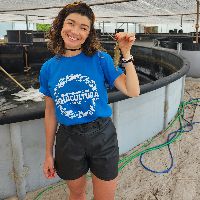Enhancing Shrimp Growth and Immunity through Feed Additives
A special issue of Fishes (ISSN 2410-3888). This special issue belongs to the section "Nutrition and Feeding".
Deadline for manuscript submissions: 15 July 2024 | Viewed by 2605
Special Issue Editors
Interests: shrimp rearing; feed science; feed additive; immune response; challenge resistance; gut health; gut microbiome; host and microbe interactions; "omics" applied to animal physiology
Interests: feed science; feed additive; fermented ingredients; immunomodulation; challenge resistance; gut health; gut microbiome
Special Issue Information
Dear Colleagues,
Shrimp are invertebrate organisms and, therefore, rely only on the innate immune response. Thus, alternative strategies are required to prevent and control the numerous diseases that impact the shrimp farming industry worldwide. Feed additives are widely used to enhance shrimp health and growth performance, comprising an important strategy for the industry. These additives include several classes of compounds, molecules, or organisms, which can be immunomodulators, disease resistance promoters, intestinal flora balancers, or nutritional, sensory, digestive, and growth enhancers.
Thus, the aim of this Special Issue is to provide up-to-date information on the enhancement of shrimp growth and immunity through feed additives. We welcome the submission of original research articles, short communication, reviews, and mini-reviews on topics including, but not limited to, the following: (1) feed additives and growth performance; (2) feed additives and immunity and disease resistance; (3) feed additives and shrimp microbiota; (4) feed additives and stress resistance; (5) fermented ingredients as feed additives.
Prof. Dr. Delano Dias Schleder
Dr. Scheila Anelise Pereira
Guest Editors
Manuscript Submission Information
Manuscripts should be submitted online at www.mdpi.com by registering and logging in to this website. Once you are registered, click here to go to the submission form. Manuscripts can be submitted until the deadline. All submissions that pass pre-check are peer-reviewed. Accepted papers will be published continuously in the journal (as soon as accepted) and will be listed together on the special issue website. Research articles, review articles as well as short communications are invited. For planned papers, a title and short abstract (about 100 words) can be sent to the Editorial Office for announcement on this website.
Submitted manuscripts should not have been published previously, nor be under consideration for publication elsewhere (except conference proceedings papers). All manuscripts are thoroughly refereed through a single-blind peer-review process. A guide for authors and other relevant information for submission of manuscripts is available on the Instructions for Authors page. Fishes is an international peer-reviewed open access monthly journal published by MDPI.
Please visit the Instructions for Authors page before submitting a manuscript. The Article Processing Charge (APC) for publication in this open access journal is 2600 CHF (Swiss Francs). Submitted papers should be well formatted and use good English. Authors may use MDPI's English editing service prior to publication or during author revisions.
Keywords
- feed additives
- unconventional ingredients
- hemato-immunological response
- shrimp health
- microbiome
- disease resistance
- environmental stress resistance
- shrimp farming
- nutrition






